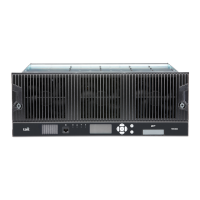TB9300 Installation and Operation Manual Working with Base Stations from Your PC 109
© Tait International Limited April 2024
5.4.15 Uploading Firmware to the Base Station
To upload firmware directly from the base station, go to Tools > Firm-
ware > Upload/Download.
5.4.16 Configuring Single Base Stations
It is possible to operate the base station as a single base station that is not
part of a channel group (for example, trunked, non simulcast, or as a
conventional single repeater). The following explains the special
considerations when configuring single base stations.
Channel Group
Membership
Although single base stations are not actually part of a channel group, their
channel configurations (Configure > Base Station > Channels) must still
select a channel group (Configure > Channel Group > Channel Groups).
Once a channel group has been selected, the following parameters need to
be configured.
Channel Group IP
Address
Set the channel group to ‘disabled’. Specify 127.0.0.1 as the channel group
IP address. This is the base station’s localhost address and stops it from
attempting to send voice packets to other base stations.
Marshaling
Duration
Single base station operation should not require marshaling. Channel group
and simulcast operation have no meaning for a single transceiver.
It is recommended to leave Tx Delay at the value of 40ms for single
base station operation.
Network Interface
(DMR/MPT
Software)
Single base stations need a control connection to their node/channel
controller. A single base station interfaces to the node/channel controller in
the same way as the master base station in a channel group. Select
Configure > Network Interfaces > DMR Network, to configure this.
5.4.17 Configuring Receive-Only Base Stations
To configure the base station as receive-only, the transmitter used within
the channel profiles needs to be off. To turn off the transmitter, navigate to
Configure > RF Interface > Channel Profiles. With the transmitter off, the
base station can even operate without a PA. If the PA is absent, it is good
practice to turn off any PA related alarms. If your base station has been
ordered as receive-only, it has been pre-configured with the transmitter
disabled. Transmit information for the receiver will be displayed in the
WebUI, but this can be ignored. Some polled SNMP parameters will return
the correct transmitter configuration data, but none of these parameters are
used by the receiver.

